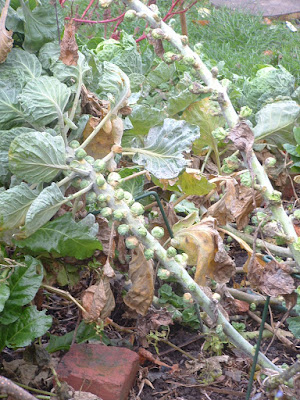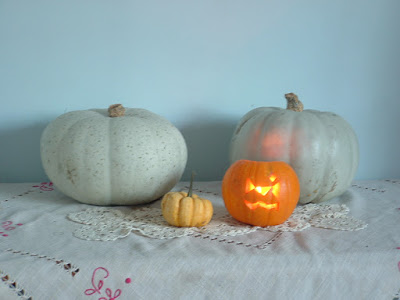 |
| Artichokes (and comfrey between them), Oct 2018 |
Roots
Harvested a handful of small beets (tasty); another handful remain, but even smaller and probably not worth the effort by now.
No celery or leeks harvested this month: both still growing.
Peas and beans
Harvested one small handful of runner beans per week throughout this month--even fewer French beans; both pretty much finished by the end of October. Left a couple pods on runner beans to save for seed.
Brassicas
Purple broccoli, Brussels sprouts, curly kale all growing strongly, but none harvested this month; all started to flop over and need staking (only staked a couple so far).
One cauliflower resolutely forming a head; the rest have disappeared. Regrowth from earlier spring cabbages forming smallish heads. Picked the one kohlrabi with an acceptably-sized bulb; another three spotted, but no real bulbs to speak of.
One small Savoy cabbage cutting still growing; half of the Savoys (from seed) planted at the allotment have wilted terribly--root fly? Don't know. The rest are good sized, though not forming heads yet. A couple old plants have regrowth; harvested a few outer leaves this month.
Planted out 18 spring cabbages in main Brassicas bed and six in the cold frame. Sowed a tray of cauliflower seed in the cold frame.
Miscellaneous
Slow growth from youngest leaf lettuces (in planters); self-sown lambs and miners lettuces and arugula also growing slowly. Harvesting a little of each throughout this month. A few smallish spring onions left in planters.
Still harvesting a handful of achocha per week throughout October--the vines of which have taken over most of the Misc bed. Finished picking Aztec broccoli mid-month, to try and let the plants go to seed.
Harvested nearly all of the regular tomatoes, and just a couple more cherry tomatoes this month--a few of these still on plants by the end of the month. Harvested a couple ripe chili peppers. Picked one ripe melon (lemon sized).
Picking chard throughout the month, both as salad greens and for cooking.
 |
| A bit late for raspberries, Oct 2018 |
Fruit
Harvested all the Sparta apples, with a couple dozen left in storage by the end of October. Harvested all the almonds.
More flowers formed on the yellow raspberry, with a couple tiny fruits too; probably too late in the year to ripen.
Leaves beginning to fall on fruit trees and bushes by the end of the month.
Perennials and herbs
Picked a tray of mint to dry for tea. Harvested a small amount of basil over the month (very nice in scrambled eggs). Most herbs died/gone dormant by the end of October.
Old growth on artichokes died back, but plenty of new growth from the base this month. A very small amount of growth spotted from the rhubarb, but asparagus is unknown. Harvested a few young sorrel leaves for salads this month, though most of the plants have died back now.










